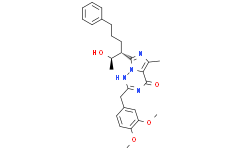| Description: |
Bay 60-7550 is a potent and selective PDE2 inhibitor with a Ki of 3.8 nM. |
| Target: |
Ki: 3.8±0.2 nM (PDE2)[1] |
| In Vivo: |
The PDE2 inhibitors Bay 60-7550 (1 mg/kg) reverses restraint stress-induced alterations in behavior, resulting in increased percentages of open-arm entries and open-arm time compared with the vehicle + restraint stress condition. In nonstressed mice, Bay 60-7550 produces a dose-dependent increase in percentages of open-arm entries and open-arm time compared with the vehicle-treated group; significant increases are observed at a dose of 3 mg/kg. In nonstressed mice, Bay 60-7550 increases, in a dose-dependent manner, the number of head-dips and time spent head-dipping, compared with vehicle-treated mice; significant increases are observed at doses of 1 and 3 mg/kg[1]. |
| In Vitro: |
Bay 60-7550 (1 μM) increases cGMP in the neuronal cultures compared with control [F(6,14)=12.97, p<0.05 for Bay 60-7550]. Bay 60-7550 in the presence of NMDA (30 μM) results in further increases in cGMP compared with NMDA alone. The NMDA receptor antagonist MK-801 (10 μM) blocks both Bay 60-7550+NMDA-induced elevation in cGMP in neuronal cultures[1]. Compared with untreated control cells, proliferation of PASMCs from IPAH patients is significantly reduced by BAY 60-7550 (1 μM)[2]. |
| Kinase Assay: |
COS-7 cells are maintained in complete DMEM (containing 10% fetal calf serum, 100 units/mL penicillin G, 100 mg/mL streptomycin, and 400 μM L-alanyl-L-glutamine) at 37°C in 5% CO2 atmosphere. A PDE2 expression plasmid is introduced into COS-7 cells using the FuGENE6 transfection reagent. Cells are lysed in solubilization buffer (275 mM NaCl, 1.5 mM MgCl2, 2 mM EGTA, 2% Triton X, 20% glycerol, and 40 mM Tris-HCl), and the cell lysates are used in the immunoprecipitation procedures. A protein A-agarose bead slurry (100 μL) is washed three times with ice-cold phosphate-buffered saline (100 mM NaCl, 2.7 mM KCl, 10.6 mM Na2HPO4, and 1.6 mM NaH2PO4) and mixed with the 5 μg of PDE2 antibody and 100 μL (2 μg/μL) of the lysate sample and rotated overnight at 4°C. The bead/sample mixture is then centrifuged at 1000g to separate the beads from the supernatant. The beads are resuspended in 100 μL of ice-cold lysis buffer (20 mM Tris, pH 7.4, 140 mM NaCl, 0.75 mM MgCl2, 1 mM EGTA, 1% Triton X-100, and 20% glycerol, containing protease and phosphatase inhibitors) to elute the PDE2 for use in the enzyme activity assays. The PDE2 activity assay is done. The recombinant PDE2 enzyme derived from COS-7 cell expression and diluted in KHEM buffer (50 mM KCl, 50 mM HEPES, 10 mM EGTA, and 1.9 mM MgCl2, pH 7.2) is mixed with different concentrations of PDE2 inhibitors (Bay 60-7550, ND7001, and EHNA) and [3H]cGMP/cGMP (5 μM) as the substrate. The mixture is then incubated for 30 min at 37°C (100 μL of reaction volume). To convert the [3H]GMP to [3H]guanosine, samples are incubated with snake venom from Crotalus atrox for 30 min at 37°C. The samples are then vortexed with a freshly prepared slurry of Dowex/water/ethanol [1:1:1, v/v] and then centrifuged for 10 min. [3H]Guanosine in the supernatant is then quantified by liquid scintillation counting. Bay 60-7550 is dissolved in dimethyl sulfoxide, EHNA is dissolved in distilled water, and ND7001 is dissolved in ethanol as 10 mM stocks and then diluted for use in assays with 20 mM Tris, pH 7.4; final concentrations of the respective solvents did not affect the assay. IC50 values at a single substrate concentration are determined by nonlinear regression analysis of the log concentration-response curves for each PDE2 inhibitor; Ki values are calculated[1]. |
| Cell Assay: |
Growth of human distal pulmonary artery smooth muscle cells isolated from patients with idiopathic pulmonary arterial hypertension (IPAH) or control cells from adults undergoing transplant or lung resection for suspected malignancy, are monitored following treatment with BAY 60-7550 (1 μM), ANP (1 μM), DETA-NONOate (10 μM), or Treprostinil (1 μM), alone or in combination[2]. |
| Animal Administration: |
Mice[1] Male ICR mice weighing 28 to 35 g are used. Bay 60-7550 (0.5, 1, and 3 mg/kg), ND7001 (0.5, 1.0, and 3 mg/kg), Detanonoate (0.5 mg/kg), L-NAME (50 mg/kg), or Diazepam (1 mg/kg) is administered after restraint stress and 30 min before behavioral testing. Mice also are treated with Bay 60-7550 (3 mg/kg), ND7001 (3 mg/kg), Detanonoate, (0.5 mg/kg), L-NAME (50 mg/kg), or diazepam (1 mg/kg) in the absence of restraint stress; drugs are administered 30 min before the behavioral tests. Bay 60-7550 shows 50-fold selectivity for PDE2 compared with PDE1, 100-fold compared with PDE5, and greater than 200-fold compared with the other PDE families. ND7001 exhibits at 1east 100-fold selectivity for inhibition of PDE2 relative to other PDE families. For antagonism tests to assess the role of cGMP signaling in the behavioral effects of the PDE2 inhibitors, ODQ, an inhibitor of soluble guanylyl cyclase (20 mg/kg), is administered 20 min before Bay 60-7550 or ND7001. |
| References: |
[1]. Masood A, et al. Anxiolytic effects of phosphodiesterase-2 inhibitors associated with increased cGMP signaling. J Pharmacol Exp Ther. 2009 Nov;331(2):690-9.
[2]. Bubb KJ, et al. Inhibition of phosphodiesterase 2 augments cGMP and cAMP signaling to ameliorate pulmonary hypertension. Circulation. 2014 Aug 5;130(6):496-507. |

 To enhance service speed and avoid tariff delays, we've opened a US warehouse. All US orders ship directly from our US facility.
To enhance service speed and avoid tariff delays, we've opened a US warehouse. All US orders ship directly from our US facility.




















